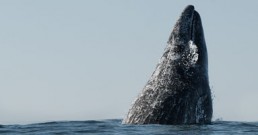Breaching Behavior Gray Whales
Why Do Gray Whales Breach
One of the most awesome sights that often happens during our tours is that of a gray whale breaching. This is where 1/2 to 3/4 of the body length comes up out of the water. When a whale is going to breach, they will swim rapidly under water and then suddenly raise its head and body up and out of the water. It will usually land on its side or back with a tremendous splash. Usually a gray whale will breach several times in a row.
There have been some studies that say calves breach more than adults which suggest that it may be more for play than anything. Some other theories range from a way to knock off external parasites, such as barnacles. Some other reason for whales breaching could be a form of courtship or a way to emphasize a visual signal. But the truth is no one knows why they do this.
Spy-Hopping
Another whale behavior that gets people excited is spy-hopping. This is where the whales head sticks straight up out of the water. One theory on spy-hopping goes against the conventional wisdom that it is to see what is happening. Some suggests that it is to help the whales hear better. It has been observed that during spy hop behavior the eyes do not always come above the surface of the water. During migration, it may be to hear the surf since their route usually follows the coastline.
When spy-hopping, the whale rises and holds position partially out of the water, exposing its entire rostrum and head. Spy-hopping is controlled slow and can last for minutes at a time. Typically, the whale’s eyes will be slightly above or below the surface of the water.
Lob-Tailing
Lob-tailing is when a whale lifts its flukes out of the water and bringing them down onto the surface to make a loud slap. Like breaching, lob-tailing is common among humpback and gray whales. It is less common, but still occasionally occurs, among other large whales.
Large whales tend to lob-tail by positioning themselves vertically downwards, then slapping the surface by bending the tail. The sound of a lob-tail can be heard underwater several hundred yards from the site of a slap. This has led to speculation among scientists that lob-tailing is a form of non-vocal communication. Some suggest that lob-tailing in humpback whales is a means of foraging. The theory is that the loud noise causes fish to become frightened, tightening the school together, making it easier for humpbacks to feed.

